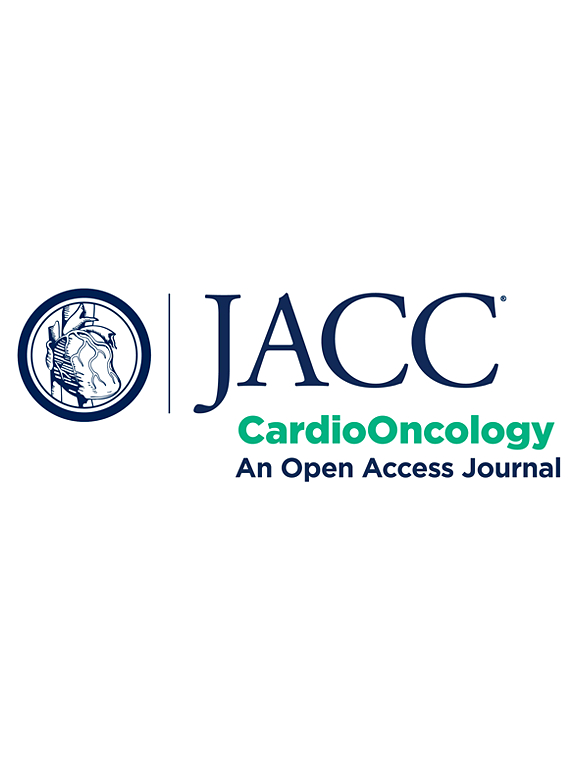Atorvastatin and Myocardial Extracellular Volume Expansion During Anthracycline-Based Chemotherapy
IF 12.8
1区 医学
Q1 CARDIAC & CARDIOVASCULAR SYSTEMS
引用次数: 0
Abstract
Background
In the STOP-CA (Statins to Prevent the Cardiotoxicity From Anthracyclines) trial, atorvastatin preserved the left ventricular ejection fraction among patients with lymphoma treated with anthracyclines. The protective mechanisms are currently unclear.
Objectives
The aim of this study was to test the effect of atorvastatin on the anthracycline-associated increase in myocardial extracellular volume (ECV) using cardiac magnetic resonance imaging (MRI).
Methods
Cardiac MRI with mapping was performed at baseline and at 12-month follow-up. ECV was calculated, and the primary endpoint was a ≥3% increase. Increases of ≥1 SD in native T1 and T2 times and ECV were secondary endpoints.
Results
The subgroup included 171 participants with paired cardiac MRI scans, and 127 had contrast scans of appropriate quality (median age 52 years, 47% women). The proportion of participants with ≥3% increases in ECV was lower in the atorvastatin compared with the placebo group (8% vs 29%; P = 0.002; OR: 0.20; 95% CI: 0.06 to 0.59). A ≥3% increase in ECV was associated with an 8.4% decrease in left ventricular ejection fraction at follow-up (95% CI: −6.31 to −10.38; P < 0.001). The proportion of participants with ≥1-SD increases in T1 and T2 times was statistically similar between groups at 12 months. At 24 months, there were fewer heart failure events among those without ≥3% increases in ECV (8% vs 24%; P = 0.054), though not statistically significantly.
Conclusions
Compared with placebo, atorvastatin limited ECV expansion among participants with lymphoma undergoing anthracycline chemotherapy. This study is the first to provide mechanistic insight into statins’ cardioprotective effects with anthracyclines. (Statins to Prevent the Cardiotoxicity From Anthracyclines [STOP-CA]; NCT02943590)
蒽环类药物化疗期间阿托伐他汀与心肌细胞外容量扩张
在STOP-CA(他汀类药物预防蒽环类药物心脏毒性)试验中,阿托伐他汀保留了接受蒽环类药物治疗的淋巴瘤患者的左心室射血分数。保护机制目前尚不清楚。目的本研究的目的是通过心脏磁共振成像(MRI)检测阿托伐他汀对蒽环类药物相关的心肌细胞外体积(ECV)增加的影响。方法在基线和随访12个月时行心脏MRI作图。计算ECV,主要终点为增加≥3%。原始T1和T2时间和ECV增加≥1 SD是次要终点。结果该亚组包括171名进行配对心脏MRI扫描的参与者,127名进行了适当质量的对比扫描(中位年龄52岁,47%为女性)。与安慰剂组相比,阿托伐他汀组ECV升高≥3%的参与者比例较低(8% vs 29%;p = 0.002;OR: 0.20;95% CI: 0.06 ~ 0.59)。随访时,ECV升高≥3%与左室射血分数降低8.4%相关(95% CI: - 6.31 ~ - 10.38;P & lt;0.001)。12个月时,T1和T2时间≥1-SD增加的参与者比例在组间具有统计学意义相似。在24个月时,ECV未增加≥3%的患者中心力衰竭事件较少(8% vs 24%;P = 0.054),但没有统计学意义。结论与安慰剂相比,阿托伐他汀限制了蒽环类化疗淋巴瘤患者的ECV扩张。这项研究首次为他汀类药物与蒽环类药物的心脏保护作用提供了机制见解。他汀类药物预防蒽环类药物的心脏毒性[STOP-CA];NCT02943590)
本文章由计算机程序翻译,如有差异,请以英文原文为准。
求助全文
约1分钟内获得全文
求助全文
来源期刊

Jacc: Cardiooncology
Multiple-
CiteScore
12.50
自引率
6.30%
发文量
106
期刊介绍:
JACC: CardioOncology is a specialized journal that belongs to the esteemed Journal of the American College of Cardiology (JACC) family. Its purpose is to enhance cardiovascular care for cancer patients by publishing high-quality, innovative scientific research and sharing evidence-based knowledge.
The journal aims to revolutionize the field of cardio-oncology and actively involve and educate professionals in both cardiovascular and oncology fields. It covers a wide range of topics including pre-clinical, translational, and clinical research, as well as best practices in cardio-oncology. Key areas of focus include understanding disease mechanisms, utilizing in vitro and in vivo models, exploring novel and traditional therapeutics (across Phase I-IV trials), studying epidemiology, employing precision medicine, and investigating primary and secondary prevention.
Amyloidosis, cardiovascular risk factors, heart failure, and vascular disease are some examples of the disease states that are of particular interest to the journal. However, it welcomes research on other relevant conditions as well.
 求助内容:
求助内容: 应助结果提醒方式:
应助结果提醒方式:


